A barlow lens is a cost-effective accessory that increases the magnification of your telescope, and it combines with your eyepieces to effectively double your viewing options.
We recommend here the Best Barlow Lenses and examine their pros and cons:
— Best 2x Barlow Lens: Celestron X-Cel LX
— Best 2.5x Barlow Lens: Celestron Luminos
— Best 3x Barlow Lens: Televue 3x
— Best 4x Barlow Lens: Televue Powermate 4x
— Best 5x Barlow Lens: Televue Powermate 5x
Best Barlow Lenses
Celestron X-Cel LX 2x Barlow Lens
Best 2x Barlow Lens
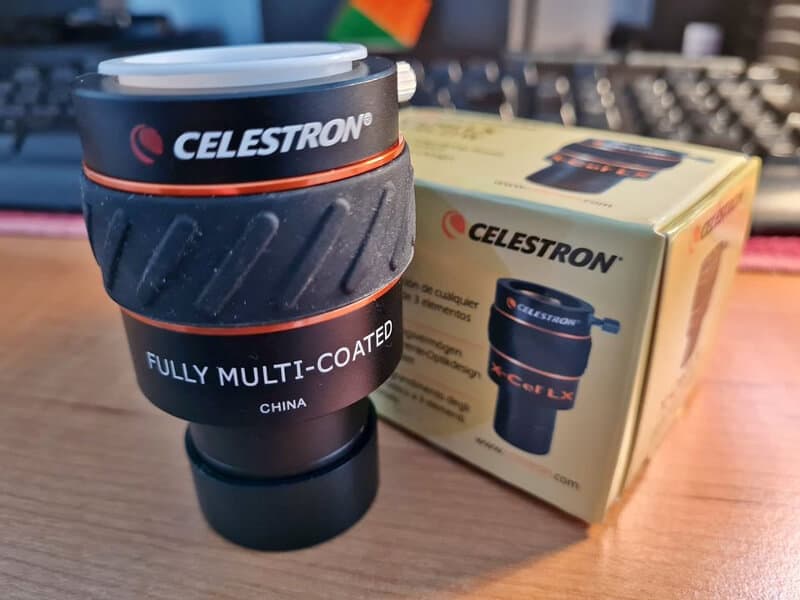
This is a high-quality and good-value barlow lens from Celestron. It fits 1.25″ eyepiece barrels and provides 2x magnification for any eyepiece used.
One of the features of this barlow lens is its 3-element fully-multicoated optical design. This ensures that you get sharp, high-contrast images, making your stargazing experience all the more immersive. And those blacked lens edges? They play a crucial role in reducing internal reflections, ensuring that you get the best view possible.
The lens also boasts a brass pressure ring. This might seem like a minor detail, but it’s essential. It ensures that your eyepiece is held securely, without any risk of damage. Plus, the rubber grip and hard black anodized finish with that signature orange ring not only make it look sleek but also ensure a comfortable grip.
Weighing in at just 4.9 oz (139 g), this Barlow lens is incredibly lightweight. Its compact design, with a total length of 2.9 inches, ensures that it’s easy to carry around, whether you’re heading to your backyard or a remote stargazing spot.
And for those who like to customize their experience, this lens is threaded for 1.25″ filters. This means you can add different filters to enhance specific observations.
The safety undercut on the barrel ensures that the lens doesn’t accidentally slip out of the focuser. Plus, the compression band in the eyepiece holder ensures a snug fit, eliminating any wobbles.
It can also be bought as a 3x barlow lens.
Key specifications
- Magnification: 2x
- Eyepiece Compatibility: 1.25-inch
- Weight: 0.35 lbs (0.16 kg)
Celestron Omni 2x Barlow Lens
Best Budget 2x Barlow Lens
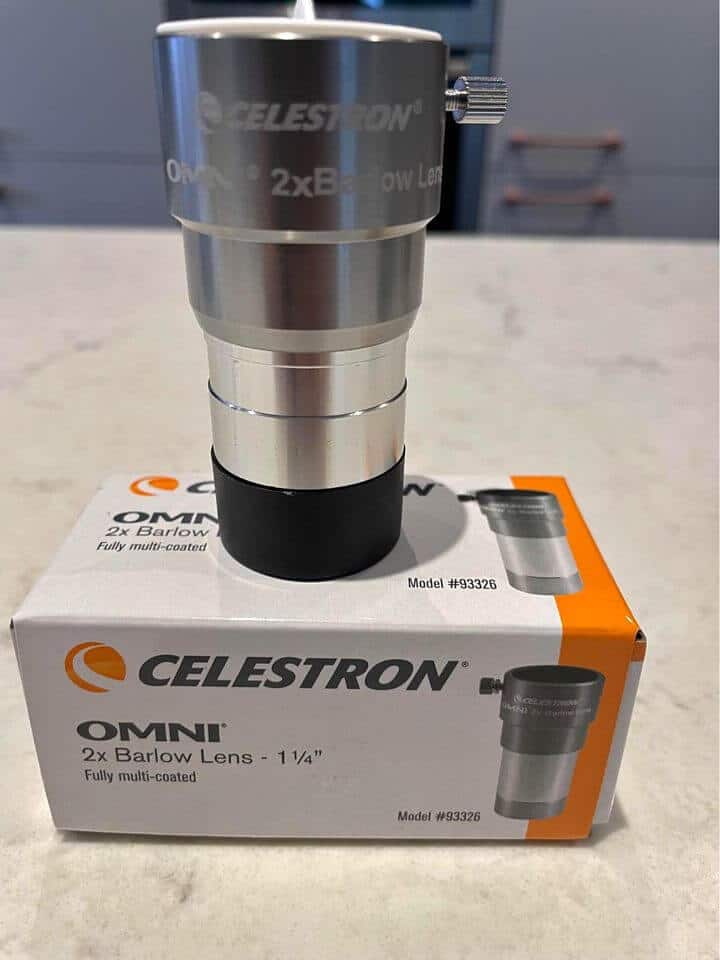
This is the budget range of Celestron barlow lenses that have slightly less high-quality coated optics but are still extremely popular.
Weighing in at a comfortable size, the Celestron Omni Barlow Lens is easy to handle and even easier to use. Its low-profile design ensures that it fits seamlessly with your existing setup.
And for those who like to experiment, the lens is threaded, allowing you to add on different filters to enhance specific observations.
Key specifications
- Magnification: 2X
- Eyepiece Compatibility: 1.25-inch
Celestron Luminos 2.5x Barlow Lens
Best 2.5x Barlow Lens
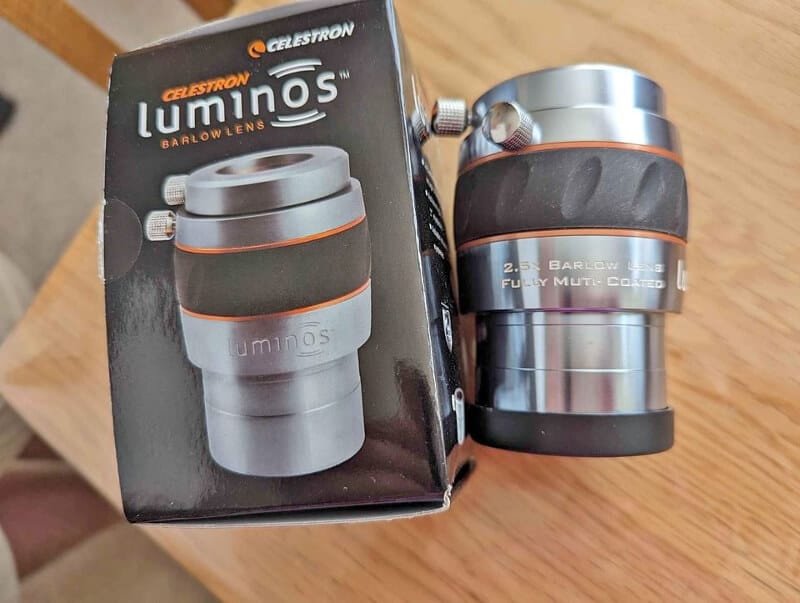
The Luminos is the premium range of Celestron barlow lenses.
It is great for those looking for 2.5X to fit 2-inch eyepiece barrels, however, it comes with an adapter so that it connects to 1.25-inch eyepieces as well.
One of the standout features is its 4-element fully multicoated design. This ensures that every image you view is sharp, vibrant, and free from distortions. The lens also minimizes chromatic aberration, ensuring that you get a true-to-life view of celestial objects.
The brass compression rings securely hold eyepieces without causing any damage to the eyepiece barrel’s finish. This means you can switch between eyepieces with ease, without worrying about wear and tear.
The rubber grip is a thoughtful addition, especially for those chilly nights when you’re out stargazing. It ensures a firm grip, even if you’re wearing gloves. The large set screw knobs further enhance the user experience, making adjustments a breeze.
For those who love to experiment, the lens is threaded to accept 2” eyepiece filters. This allows you to enhance specific observations, be it planetary details or deep-sky objects.
Key specifications
- Magnification: 2.5X
- Eyepiece Compatibility: 2-inch and 1.25-inch
- Weight: 0.7 lbs (0.3 kg)
Televue 3x Barlow Lens
Best 3x Barlow Lens
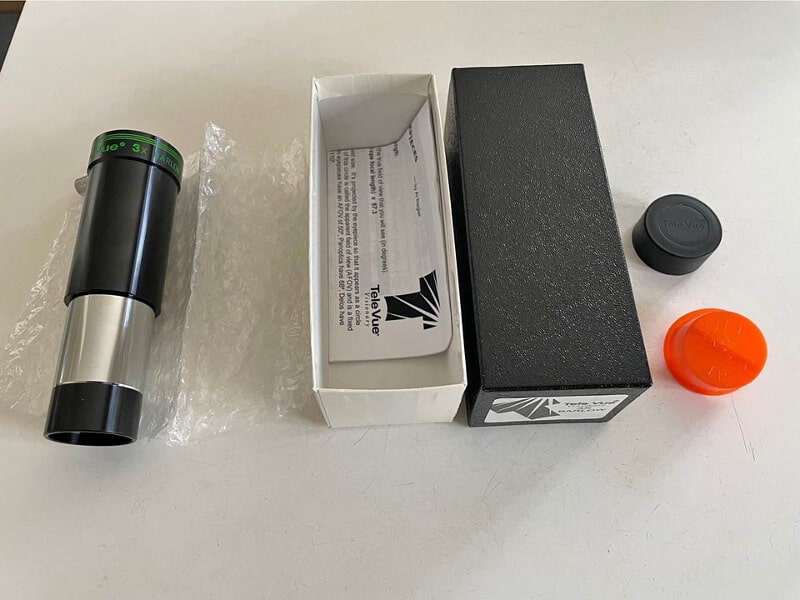
Televue is possibly the most respected manufacturer of eyepieces and barlow lenses by experienced astronomers.
This is a 3x barlow that will fit virtually any telescope.
It features multi-coated high-index glass. This ensures that every image you view is sharp, vibrant, and free from distortions.
The lens also minimizes chromatic aberration, ensuring that colors remain true to life.
The blacked lens edges further enhance the viewing experience by reducing stray light, ensuring that every celestial object stands out against the backdrop of the night sky.
It has been designed to complement the high performance of Tele Vue eyepieces.
The brass compression rings ensure eyepieces are held securely without causing any damage. This means you can switch between eyepieces with confidence, knowing that they are safe and secure.
The lens is also parfocal, ensuring that minimal adjustments are needed when switching between eyepieces.
Key specifications
- Magnification: 3X
- Eyepiece Compatibility: 1.25-inch
- Weight: 0.5 lbs (0.2 kg)
Televue Powermate 4x and 5x Barlow Lenses
Best 4x Barlow Lens and Best 5x Barlow Lens
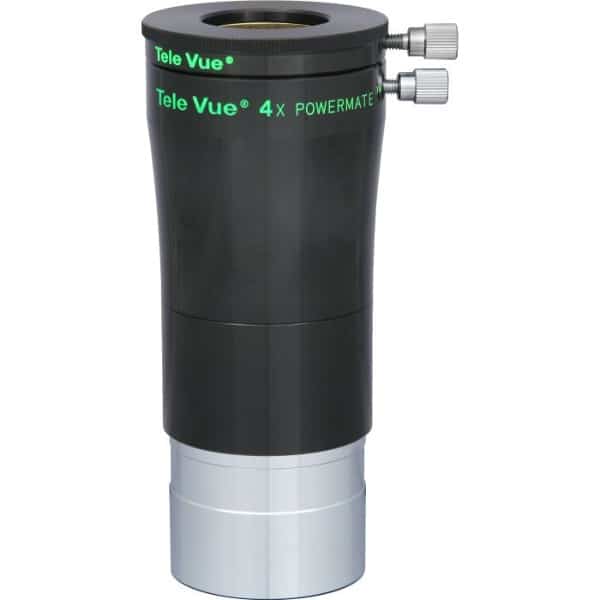
The Tele Vue Powermate Barlow Lenses are available at 4x and 5x magnification and are designed to be compatible with both 1.25” and 2” eyepieces.
As with the 3x model above, they are designed to an ultra-high standard and have a legion of fans in the astronomy world.
They feature all the advantages listed above in terms of minimal chromatic aberration
They minimize chromatic aberration, ensuring that colors are vivid and accurate. The blacked lens edges further enhance the viewing experience by reducing stray light, ensuring that every celestial object is brilliantly illuminated against the backdrop of the night sky.
The brass compression rings ensure that eyepieces are held securely, allowing you to switch between them with confidence. The lens is also parfocal, which means minimal adjustments are needed when switching between eyepieces. This is a feature that I particularly appreciated, as it made my observations seamless and hassle-free.
Key specifications
- Magnification: 4X and 5x
- Eyepiece Compatibility: 2-inch and 1.25-inch
What is a Barlow Lens?
A barlow lens is a type of lens that artificially increases the focal length of the telescope.
It fits between the eyepiece and the telescope and multiplies the magnification. This can be double magnification for a 2x barlow lens, triple for a 3x, and so on.
Magnification is how many times larger an image appears in your telescope compared to the naked eye. For example, 20x magnification makes the object 20 times larger.
The magnification of a telescope can be calculated by taking the telescope’s focal length and dividing it by the eyepiece focal length. For example:
- A Celestron NexStar Evolution 8 telescope has a 2032mm focal length and comes with 40mm and 13mm eyepieces. Therefore its magnification is 50x with the 40mm eyepiece and 156x with the 13mm eyepiece.
- A Celestron StarSense Explorer DX 130AZ telescope has a 650mm focal length and comes with 25mm and 10mm eyepieces. Therefore the magnification is 26x with the 25mm eyepiece and 65x with the 10mm eyepiece.
As you can see, the shorter the eyepiece focal length, the higher the magnification.
By adding a barlow lens to use with these eyepieces you can effectively double your options. So if you have 40mm and 13mm eyepieces, you can insert a 2x barlow and effectively also have 20mm and 7.5mm eyepieces.
Here is a great and short video from Celestron that gives a good overview of what a barlow lens is and how it works.
Pros and Cons of Barlow Lenses
The advantages of using a barlow lens are:
- Higher magnification results in astronomical objects appearing larger through your telescope.
- You can effectively double your eyepiece collection by combining each of them with the barlow.
- You can maintain your eyepiece’s eye relief whilst increasing magnification – high-powered eyepieces (like 10mm) have low eye relief (meaning you have to place your eye very close to the eyepiece, but with lower-powered eyepieces (like 20mm) you can look from further away (especially important if you wear glasses).
- They are relatively cheap in comparison to eyepieces.
The disadvantages of using a barlow lens are:
- Whilst, the higher magnification might make objects larger, it will also increase any distortion caused by turbulence in the air, therefore making views blurrier.
- Adding a barlow lens will also result in a view that is generally about 3% dimmer at any time.
- It’s another piece of kit to buy and maintain along with your telescope, mount, tripod, eyepieces, etc.
Different Types of Barlow Lens
Most commonly barlow lenses are 2x or 3x, however 2.5x, 4x and 5x can also be found.
Another differentiating factor between barlow lenses is compatibility with your telescope eyepieces. This is indicated by whether the barlow lens is for 1.25-inch or 2-inch eyepiece barrels. The majority of telescopes have 1.25-inch eyepiece barrels and so that will be what is right for most people.
Barlow Lens FAQs
What barlow lens is right for me?
There are three things to note when buying a barlow lens:
- The first thing to do is to look at your existing eyepiece collection. As noted above, adding a barlow lens effectively doubles your eyepiece functionality so you should look at what you’ve got and decide whether 2x, 3x, or something else is right for you.
- You should know that barlow lenses from different manufacturers are compatible with all telescopes. I.e. you can use an Orion barlow with a Celestron telescope, and vice versa.
- For the vast majority of telescopes, you will need a 1.25-inch compatible barlow, and this is the majority of them on the market. Only some bigger telescopes may use 2-inch barlows.
Here’s a good video from Orion that talks about all this:
Is a 2x or 3x barlow lens better?
When deciding between a 2x and 3x barlow lens, look at your current eyepieces and calculate the magnification of your telescope and work out what doubling or tripling the magnification would give you.
For example, the Celestron NexStar Evolution 8 telescope has:
- 2032mm focal length and 203mm aperture. It comes with 40mm and 13mm eyepieces.
- Its theoretical limit for magnification is 2 x 203 (double the aperture), which is 406x.
- Its magnification is 50x with the 40mm eyepiece and 156x with the 13mm eyepiece.
- Using a 2x barlow will give you 100x with the 40mm eyepiece and 312x with the 13mm eyepiece, and using a 3x barlow will give you 150x with the 40mm eyepiece and 468x with the 13mm eyepiece.
Therefore in this case, using the 3x with the 13mm eyepiece would be overkill and exceed the theoretical limit of the telescope and therefore not be worth it as the views would be poor quality. Therefore a 2x would make more sense.
In another example, a Celestron StarSense Explorer DX 130AZ has:
- 650mm focal length and 130mm aperture. It comes with 25mm and 10mm eyepieces.
- Its theoretical limit for magnification is 2 x 130, which is 260x.
- Its magnification is 26x with the 25mm eyepiece and 65x with the 10mm eyepiece.
- Using a 2x barlow will give you 52x with the 25mm eyepiece and 130x with the 10mm eyepiece, and using a 3x barlow will give you 78x with the 25mm eyepiece and 195x with the 10mm eyepiece.
Therefore, in this case, using a 3x barlow would be within the limit of the telescope and eyepieces and therefore may make as much sense as a 2x.
How to use a barlow lens?
You can use a barlow lens in two ways:
- Between your eyepiece and diagonal
- Between the diagonal and telescope
The difference is the magnification is effectively increased further with the second technique.
For example, a 2x barlow lens between the eyepiece and the diagonal will give you 2x magnification. However, putting the barlow lens between the telescope and the diagonal will increase this to 3x.
Note, this only works with refractors and catadioptric telescopes, not reflectors.
Is higher magnification better?
No, higher magnification is not always better. It will zoom you in more to what you are looking at but it will not make it brighter or clearer, in fact with a barlow, it will likely degrade the view slightly (although this may not be noticeable).
Your telescope’s aperture is the best indicator of how good the views it will provide are.
Related to this, each telescope has its own theoretical limit. This is the point at which it will no longer be beneficial to increase the magnification as the image will degrade.
This is easily calculated by taking your telescope’s aperture in millimeters and doubling it. Therefore:
- A 90mm (3.5-inch) aperture telescope should only be used up to 180x magnification
- A 150mm (6-inch) aperture telescope can be used up to 300x magnification
You should use this calculation when buying a barlow lens to help you decide what is best for you, as there is no point in exceeding the theoretical limit.
When should you use a barlow lens?
Barlow lenses are particularly useful in lunar and planetary viewing when increased magnification will get you much closer to what you are viewing and where narrower fields of view are more beneficial.
Can you use a barlow lens for astrophotography?
Yes, you can use a Barlow Lens for astrophotography, but this will be best for photographing the moon and planets of our solar system where higher focal length and magnification are positive.
This is because these objects in our solar system are relatively close to us and relatively small. Higher magnification will allow you to get much closer to these objects for imaging.
In comparison, deep sky objects like galaxies and nebulae are very far away and very large and so with this wide-field imaging (or observing), higher focal length and magnification are not helpful as you will only result in capturing narrow sections of the sky.
In terms of metrics, a 2x Barlow Lens will also double your focal ratio (and a 3x will triple it). This means a slower aperture that will degrade imaging.
Can you stack barlow lenses?
Yes, stacking barlow lenses can be done to further multiply the magnification.
Remember though, you may exceed your telescope’s theoretical limit, adding the extra component will further dim the view, and further increasing the magnification with also increase any distortion and so you will not necessarily end up with better views doing this.
Why is my barlow lens blurry?
When using a barlow lens, you are adding more glass and layers for the light to pass through and so there is some degradation.
Also, when it doubles or triples the magnification it also doubles or triples any turbulence in the air and so can produce blurry views.
This is especially so if you exceed the theoretical limit of your telescope’s aperture (see above).
Verdict – The Best Barlow Lens
In summary, when buying a barlow lens you should do some assessment of your telescope’s theoretical limit and what eyepieces you currently have to work out what is best for you from 2x, 3x, 5x etc.
In terms of different models, the more expensive premium ranges from Televue and Celestron will give you better optics and will be worth it if you have good-quality eyepieces.
The cheaper Celestron barlows may be ok if you are just playing around with a lower aperture telescope and the eyepieces that came with it.



